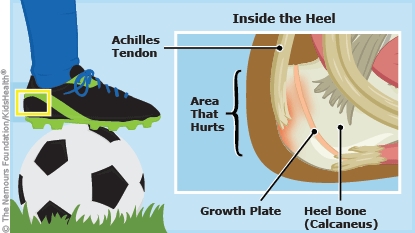- Parents Home
- Para Padres
- A to Z Dictionary
- Allergy Center
- Asthma
- Cancer
- Diabetes
- Diseases & Conditions
- Doctors & Hospitals
- Emotions & Behavior
- First Aid & Safety
- Flu (Influenza)
- Food Allergies
- General Health
- Growth & Development
- Heart Health & Conditions
- Homework Help Center
- Infections
- Newborn Care
- Nutrition & Fitness
- Play & Learn
- Pregnancy Center
- Preventing Premature Birth
- Q&A
- School & Family Life
- Sports Medicine
- Teens Home
- Para Adolescentes
- Asthma
- Be Your Best Self
- Body & Skin Care
- Cancer
- Diabetes
- Diseases & Conditions
- Drugs & Alcohol
- Flu (Influenza)
- Homework Help
- Infections
- Managing Your Weight
- Medical Care 101
- Mental Health
- Nutrition & Fitness
- Q&A
- Safety & First Aid
- School, Jobs, & Friends
- Sexual Health
- Sports Medicine
- Stress & Coping
Sever's Disease
What Is Sever's Disease?
Sever's disease is a swelling and irritation of the growth plate in the heel. The growth plate is a layer of near the end of a bone where most of the bone's growth happens. It is weaker and more at risk for injury than the rest of the bone.
With proper management, Sever's disease usually goes away within a few months and doesn't cause lasting problems.
What Are the Signs & Symptoms of Sever's Disease?
Sever's disease usually causes pain or tenderness in one or both heels. It also can lead to:
- swelling and redness in the heel
- stiffness in the feet when first waking up
- limping, or walking on tiptoes
- pain when the heel is squeezed on both sides
Symptoms are usually worse during or after activity and get better with rest.
What Causes Sever's Disease?
Sever's disease happens during the growth spurt of puberty. During a growth spurt, the bones, muscles, and tendons grow at different rates. The muscles and tendons can become tight, pulling on the growth plate in the heel. Activities and sports pull on the tight muscles and tendons, injuring the growth plate. This injury leads to the pain of Sever's disease.

Less often, Sever's disease can happen from standing too long, which puts constant pressure on the heel.
Who Gets Sever's Disease?
Sever's disease usually happens in kids who are:
- in their growth spurt (usually 9–14 years old)
- active in sports or activities that involve a lot of running or jumping, especially on hard surfaces (such as basketball, gymnastics, and track)
How Is Sever's Disease Diagnosed?
To diagnose Sever's disease, health care providers:
- ask about a child's physical activities
- do an exam, paying special attention to the heel
Usually no testing is needed. Although Sever's disease can't be seen on X-rays, health care providers sometimes order them to check for other problems.
How Is Sever's Disease Treated?
A child with Sever's disease needs to cut down or avoid all activities that cause pain. Walking and non-weight bearing exercises (like swimming) are usually OK.
If your child has Sever's disease, your health care provider may recommend doing some or all of these:
- Put ice or a cold pack on the heel every 1–2 hours, for 15 minutes at a time. (Put a towel over the skin to protect it from the cold.)
- Give medicine for pain such as ibuprofen (Advil, Motrin, or store brand) or acetaminophen (Tylenol or store brand). Follow the directions that come with the medicine for how much to give and how often to give it.
- Use heel gel cups or supportive shoe inserts to lower the stress on the heel.
- Wear shoes that are open in the back so the heel is not irritated.
- Use an elastic wrap or compression stocking to help with pain and swelling.
- Try physical therapy (PT) or a home exercise program given to you by the health care provider to help with stretching and strengthening.
- Wear a walking boot that limits the movement of the ankle/heel.
Sometimes a short leg cast is put on for about a week if:
- Symptoms are severe.
- Symptoms don't go away with a few weeks of rest and treatment.
Can Kids with Sever's Disease Still Do Sports?
Kids can go back to sports when the activity does not cause any pain.
Looking Ahead
With rest, Sever's disease usually gets better within 2 weeks to 2 months. Most kids can do all of the sports and activities that they did before.
After healing, your child can help prevent Sever's disease from coming back by:
- wearing shoes and sneakers that fit well and have padded soles
- avoiding heavy or high-heeled shoes
- stretching before and after activity and sports
- putting ice on the heel for 15 minutes after activity and sports (with a towel over the skin to protect it from the cold)
- using special shoe inserts
- losing weight (if overweight)
Usually by age 15, the growth plate is finished growing. After that, your child won't get Sever's disease again.

© 1995- The Nemours Foundation. KidsHealth® is a registered trademark of The Nemours Foundation. All rights reserved.
Images sourced by The Nemours Foundation and Getty Images.
